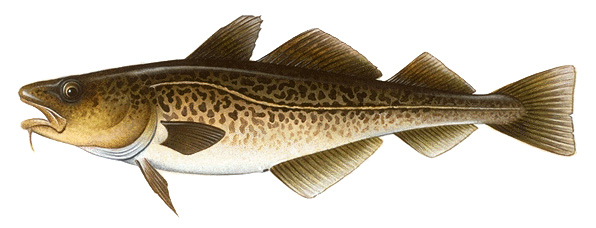Cod are any of a group of fishes mainly from cold waters of the Atlantic and Pacific oceans. Cod belong to the codfish family, which also includes haddock and pollock. Cod once ranked among the world’s major food fishes. But overfishing and other factors have greatly reduced cod populations since the early 1990’s. Despite their reduced numbers, cod remain popular food fishes.
Cod have three fins on the back and two fins on the underside near the tail. A barbel (fleshy growth) extends from the end of the chin. It acts as a sense organ used to locate food. Cod vary in color from gray to red to brown or black, with spotted upper parts. Most adult Atlantic cod measure from 11/2 to 3 feet (0.5 to 0.9 meter) long and weigh from 5 to 25 pounds (2.3 to 11 kilograms). But fish of up to 6 feet (1.8 meters) and over 200 pounds (91 kilograms) have been recorded. The Pacific cod rarely exceeds 3 feet (91 centimeters) long and usually weighs from 3 to 20 pounds (1.4 to 9 kilograms). The Greenland cod typically grows no more than 2 feet (60 centimeters) long and weighs 3 to 8 pounds (1.4 to 3.6 kilograms).

Cod live near the ocean floor, but they often swim up to midwater and sometimes approach the surface while feeding. Though not particularly strong swimmers, the fish can reach speeds of 4 miles (6 kilometers) per hour.
Cod spawn (produce eggs) offshore during late winter and early spring. Depending on its size, a cod may produce from about 1 million to more than 9 million eggs at a time, sometimes spawning several times in a season. But only a small percentage of the eggs develop into mature fish. Cod usually spawn near the ocean bottom. The free-floating eggs then rise to the surface and become part of the plankton—the mass of small, drifting aquatic organisms. Newly hatched fish feed on the plankton. When the cod reach 1 to 2 inches (2.5 to 5 centimeters) long, they move to the ocean bottom, where they feed on worms and small shrimp.
Some cod migrate in response to seasonal changes in water temperature. Cod also may migrate to spawn and to search for food. Mature cod eat small fish, squid, and such shellfish as clams, crabs, and shrimp. Animals that prey on cod include sharks, eels, and other fish.
Atlantic cod live around Iceland and in the Barents, Norwegian, Baltic, and North seas. A large population also inhabits George’s Bank, off Boston. Norway, Russia, and Japan rank among the leading Atlantic cod fishing nations. The Pacific cod ranges from the waters off California north to the Bering Sea and west to Japan and North and South Korea. The United States, Russia, and Japan rank as the leading countries in catching Pacific cod. Greenland cod occur from Alaska to western Greenland and along the Canadian coast to the Gulf of St. Lawrence. A separate population inhabits the White Sea, an arm of the Arctic Ocean that reaches northwestern Russia. Greenland accounts for most of the annual catch of this cod species.
When cod is split, salted, and dried, it can be kept for long periods without spoiling. In past centuries, ships could not carry perishable food on long voyages because there was no refrigeration. Cod became an important food on such voyages. As early as the late 1400’s, European fishing crews crossed the Atlantic to catch cod.
Demand for cod increased sharply after the introduction of precooked codfish sticks in the 1950’s. Since the early 1990’s, however, Atlantic cod have declined greatly because of overfishing and improper management of cod stocks. Restrictions placed on cod fishing in the 1990’s were designed to help the species recover. By the late 2010’s, however, a recovery had not yet occurred. Cod provides a source of cod-liver oil, a food supplement rich in vitamins A and D.
See also Cod-liver oil; Murray cod.
